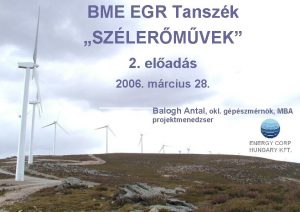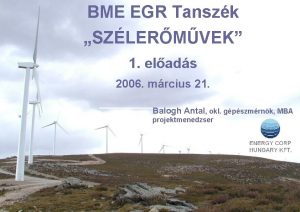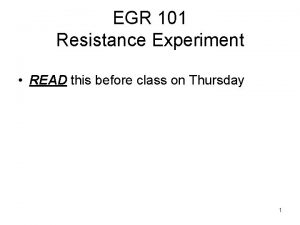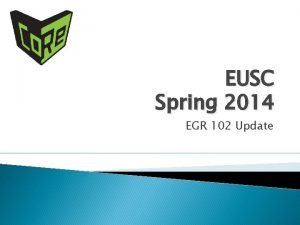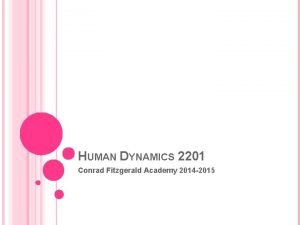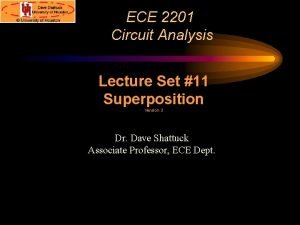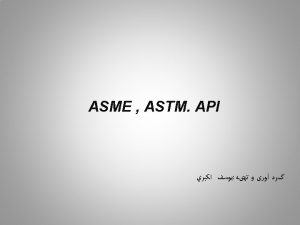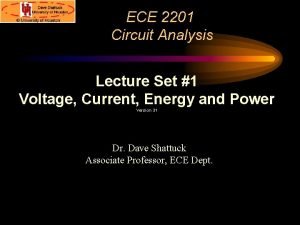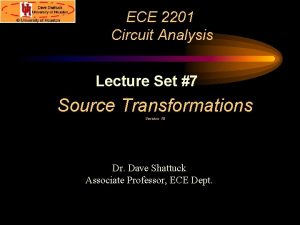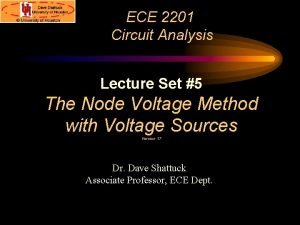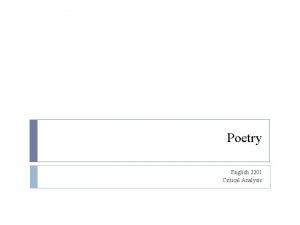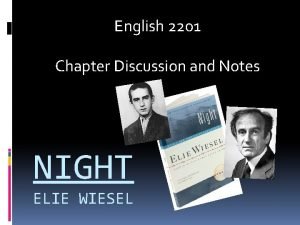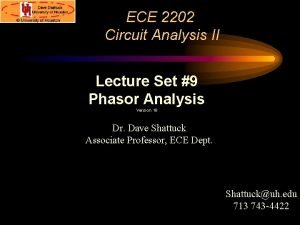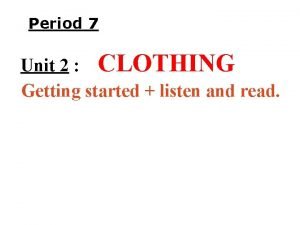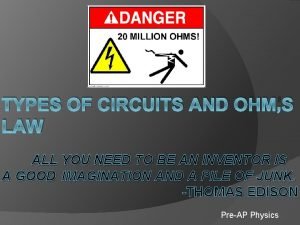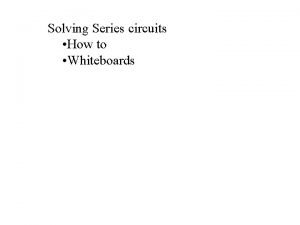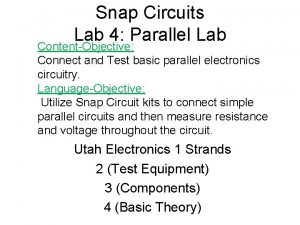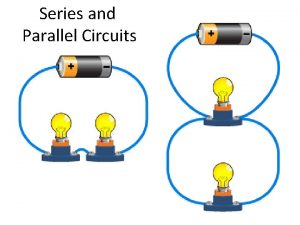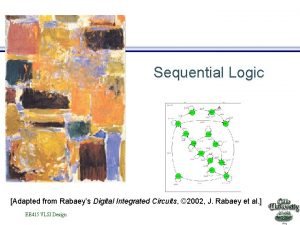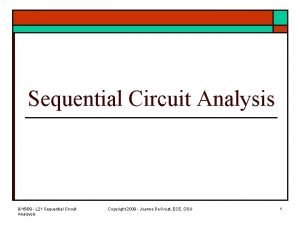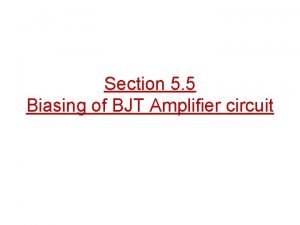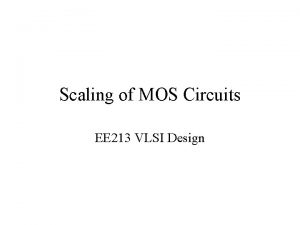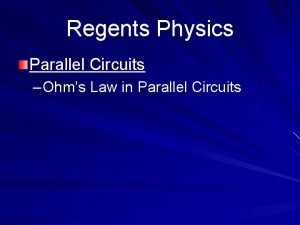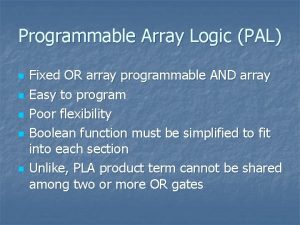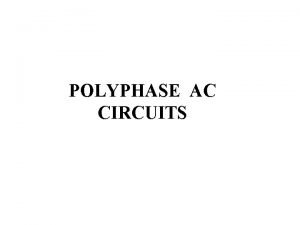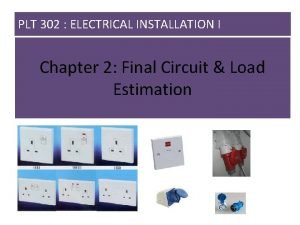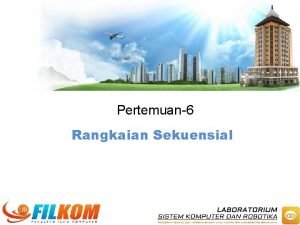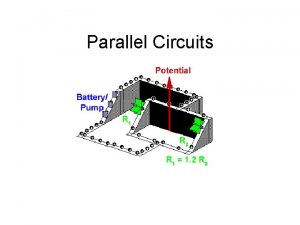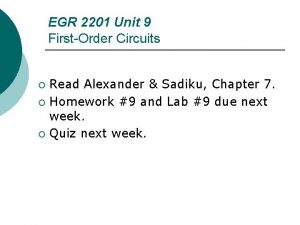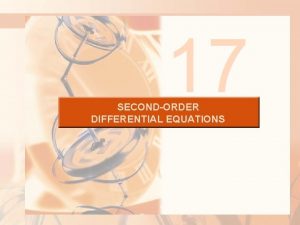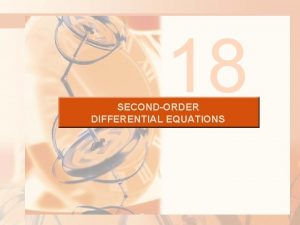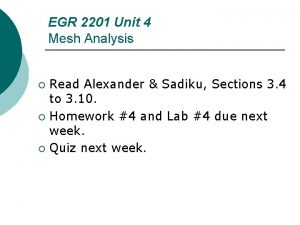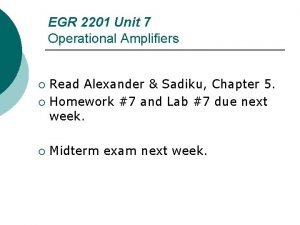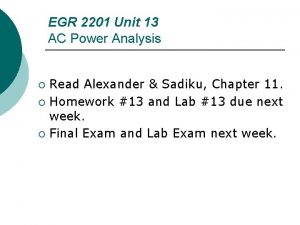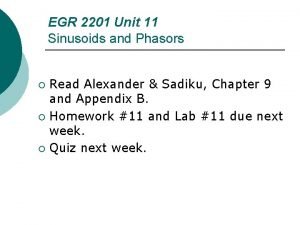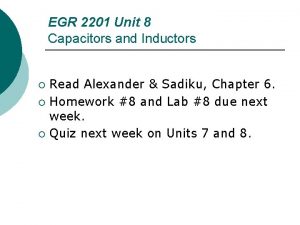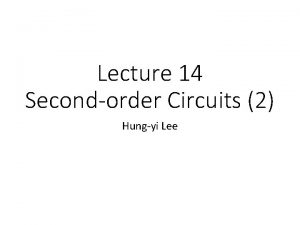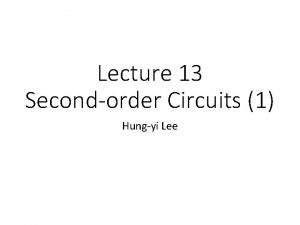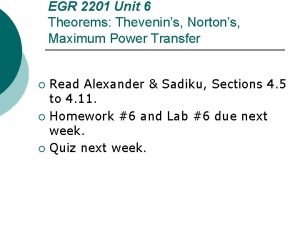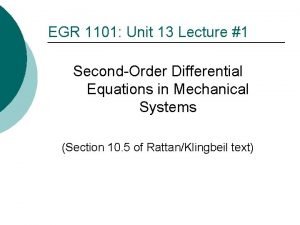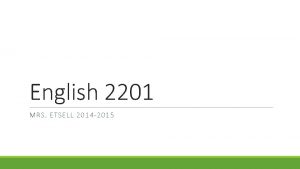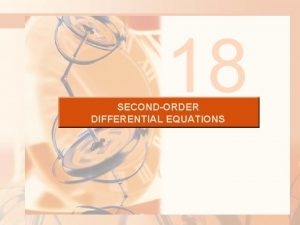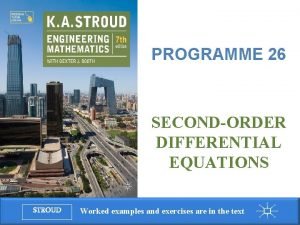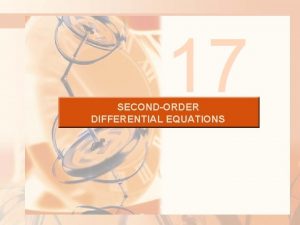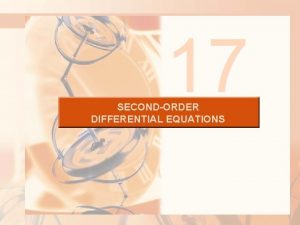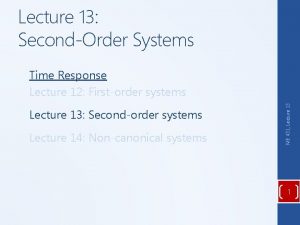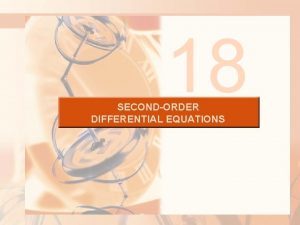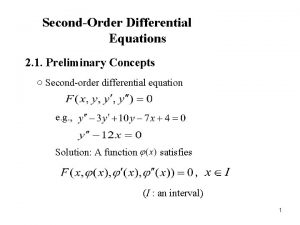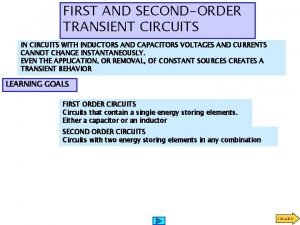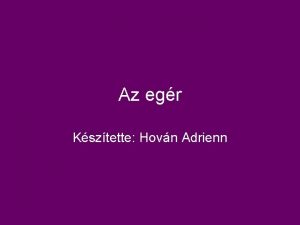EGR 2201 Unit 10 SecondOrder Circuits Read Alexander








































- Slides: 40

EGR 2201 Unit 10 Second-Order Circuits Read Alexander & Sadiku, Sections 8. 1 through 8. 4. ¡ Homework #10 and Lab #10 due next week. ¡ Quiz next week. ¡

Review: Four Kinds of First-Order Circuits ¡ ¡ The circuits we studied last week are called first-order circuits because they are described mathematically by first-order differential equations. We studied four kinds of first-order circuits: l Source-free RC circuits l Source-free RL circuits l RC circuits with sources l RL circuits with sources

Review: A General Approach for First-Order Circuits (1 of 3) ¡

Review: A General Approach for First-Order Circuits (2 of 3) ¡

Review: A General Approach for First-Order Circuits (3 of 3) ¡ Steady-state response Transient response

Transient Analysis with Multisim ¡ The textbook’s Sections 7. 8 and 8. 9 discuss using PSpice simulation software to perform transient analysis of first-order and secondorder circuits. ¡ We can also do this with Multisim, as shown here. l The steps are summarized in Lab 10.

Our Goal: A General Approach for Second-Order Circuits ¡ Next we will develop a general approach for analyzing more complicated circuits called secondorder circuits. ¡ Unfortunately the general approach for second-order circuits is quite a bit more complicated than the one for first-order circuits.

Second-Order Circuits ¡ ¡ The circuits we’ll study are called second-order circuits because they are described mathematically by second -order differential equations. Whereas first-order circuits contain a single energy-storing element (capacitor or inductor), second-order circuits contain two energy-storing elements. l These two elements could both be capacitors or both be inductors, but we’ll focus on circuits containing one capacitor and one inductor.

Four Kinds of Second-Order Circuits ¡ The book treats four kinds of second-order circuits: l Source-free series RLC circuits l Source-free parallel RLC circuits l Series RLC circuits with sources (We won’t cover these. ) l Parallel RLC circuits with sources (We won’t cover these. )

Natural Response and Step Response ¡ ¡ ¡ Recall that the term natural response refers to the behavior of source-free circuits. And the term step response refers to the behavior of circuits in which a source is applied at some time. So the goal of this chapter in the book is to understand the natural response of source-free RLC circuits, and to understand the step response of RLC circuits with sources.

Redraw, Redraw! ¡ Our procedure will usually require us to find values of voltages or currents at the following three times: l l l ¡ At t = 0 , just before a switch is opened or closed. At t = 0+, just after a switch is opened or closed. As t , a long time after a switch is opened or closed. Usually the circuit looks different at these three times, so you’ll want to redraw the circuit for each of these times.

Finding Initial Values ¡ To completely solve a first-order differential equation, you need one initial condition, usually either: l l ¡ An initial inductor current i(0+), or An initial capacitor voltage v(0+). To completely solve a second-order differential equation, you need two initial conditions, usually either: l l An initial inductor current i(0+) and its derivative di(0+)/dt, or An initial capacitor voltage v(0+) and its derivative dv(0+)/dt.

Finding Initial Derivative Values ¡ To find initial derivative values such as dv(0+)/dt, we’ll rely on the basic relationships for capacitors and inductors: ¡ For example, if we know a capacitor’s initial current i(0+), then we can use the left-hand equation above to find the initial derivative of that capacitor’s voltage, dv(0+)/dt.

Quantities that Cannot Change Abruptly ¡ We’ll also rely on the fact that a capacitor’s voltage and an inductor’s current cannot change abruptly. l l Example: In this circuit, i(0+) must be equal to i(0 ), and v(0+) must be equal to v(0 ). Since these values must be equal, we don’t really need to distinguish between their values at time t = 0 and at time t = 0+. So we could just write i(0) instead of i(0+) and i(0 ).

Caution: Some Quantities Can Change Abruptly ¡ Don’t assume that every quantity has the same value at times t = 0 and t = 0+. ¡ ¡ Example: In the same circuit, i. C(t) changes abruptly from 0 A to 2 A at time t = 0. So we must distinguish between i. C(0 ) and i. C(0+): l i. C(0 ) = 0 A l i. C(0+) = 2 A l i. C(0) is undefined.

Finding Final Values ¡ Our procedure will sometimes also require us to find final or “steady-state” values, such as: l l ¡ A final inductor current i( ) A final capacitor voltage v( ). Usually these final values are easier to find than initial values, because: 1. 2. We don’t have to worry about abrupt changes as t , so we never need to distinguish between t and t +. We don’t have to find derivatives of currents or voltages as t .

Natural Response of Source-Free Series RLC Circuit (1 of 2) ¡ ¡ ¡ Consider the circuit shown. Assume that at time t=0, the inductor has initial current I 0, and the capacitor has initial voltage V 0. As time passes, the initial energy in the capacitor and inductor will dissipate as current flows through the resistor. This results in changing current i(t), which we wish to calculate.

Natural Response of Source-Free Series RLC Circuit (2 of 2) ¡

A Closer Look at Our Differential Equation ¡

Solving Our Differential Equation (1 of 4) ¡

Solving Our Differential Equation (2 of 4) ¡

Solving Our Differential Equation (3 of 4) ¡

Solving Our Differential Equation (4 of 4) ¡

The Overdamped Case ( > 0) ¡ Real number

The Critically Damped Case ( = 0) ¡ Zero

The Underdamped Case ( < 0) ¡ Imaginary number

Graphs of the Three Cases ¡ ¡ Details will differ based on initial conditions and element values, but the shapes shown here are typical. Note the oscillation in the underdamped case.

Typing Equations in Word 2013 1. Select Insert > Equation on Word’s menu bar. 2. Use the toolbar’s Structures section to create fractions, exponents, square roots, and more. 3. Use the toolbar’s Symbols section to insert basic math symbols, Greek letters, special operators, and more.

Oscilloscope ¡ Looking ahead, we’ll use an oscilloscope to display and measure fast-changing voltages, including transients.

Oscilloscope Challenge Game The oscilloscope is a complex instrument that you must learn to use. ¡ To learn the basics, play my Oscilloscope Challenge game at ¡ http: //nreeder. com/flashgames. htm.

Natural Response of Source-Free Parallel RLC Circuit (1 of 2) ¡

Natural Response of Source-Free Parallel RLC Circuit (2 of 2) ¡

Solving Our Differential Equation ¡

The Overdamped Case ( > 0) ¡

The Critically Damped Case ( = 0) ¡

The Underdamped Case ( < 0) ¡

Graphs of the Three Cases ¡ ¡ Details will differ based on initial conditions and element values, but the shapes shown here are typical. Note the oscillation in the underdamped case.

A General Approach for Source-Free Series or Parallel RLC Circuits (1 of 3) ¡

A General Approach for Source-Free Series or Parallel RLC Circuits (2 of 3) ¡

A General Approach for Source-Free Series or Parallel RLC Circuits (3 of 3) ¡
 Advantages of parallel circuits over series circuits
Advantages of parallel circuits over series circuits Two technicians are discussing clogged egr passages
Two technicians are discussing clogged egr passages Bme egr
Bme egr Bme egr
Bme egr Egr 101
Egr 101 Egr 102
Egr 102 Conrad fitzgerald academy
Conrad fitzgerald academy Ece 2201
Ece 2201 Api rp 2201
Api rp 2201 Watt definition
Watt definition Ece 2201
Ece 2201 Ece 2201
Ece 2201 Biology 2201
Biology 2201 Jack the
Jack the Symbolism in night elie wiesel
Symbolism in night elie wiesel Uh ece 2201
Uh ece 2201 Unit 10, unit 10 review tests, unit 10 general test
Unit 10, unit 10 review tests, unit 10 general test Unit 13 festivals read
Unit 13 festivals read Unit 2 clothing listen and read
Unit 2 clothing listen and read Listen and read unit 3
Listen and read unit 3 The old lamp is five dollars. it’s made in china
The old lamp is five dollars. it’s made in china Lesson outline lesson 3 describing circuits answers
Lesson outline lesson 3 describing circuits answers Example of virtual circuit network
Example of virtual circuit network Types of circuits and ohm's law answer key
Types of circuits and ohm's law answer key Crossed extensor reflex
Crossed extensor reflex Special-purpose op-amp circuits
Special-purpose op-amp circuits Solving series circuits
Solving series circuits Snap circuit lab
Snap circuit lab Parallel vs series
Parallel vs series Facts about parallel circuits
Facts about parallel circuits Non bistable sequential circuits
Non bistable sequential circuits Analysis of sequential circuits
Analysis of sequential circuits Bjt amplifier circuit
Bjt amplifier circuit Scaling factors in vlsi
Scaling factors in vlsi Internal resistance
Internal resistance Programmable array logic circuit
Programmable array logic circuit What are complete and incomplete circuits
What are complete and incomplete circuits Polyphase ac circuit
Polyphase ac circuit Radial circuits
Radial circuits Synchronous sequential circuits examples
Synchronous sequential circuits examples Series-parallel circuit formula
Series-parallel circuit formula


